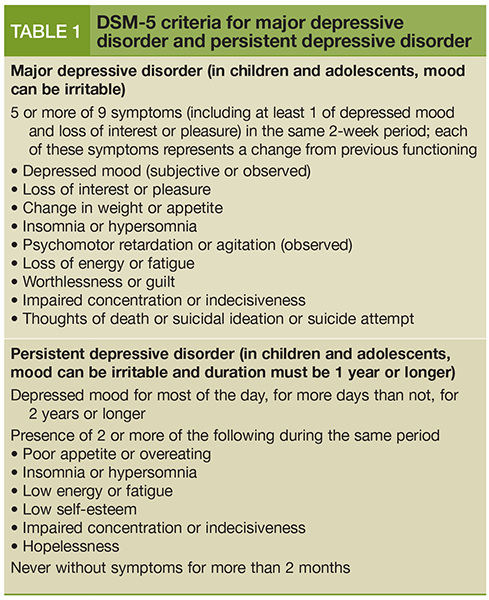Major Depressive Disorder With Psychotic Features Diagnostic Criteria
criteria diagnostic disorder majorCurrent severity and psychotic features are only indicated if full criteria are currently met for a major depressive episode. Psychosis refers to a disconnection from reality and may include symptoms such as hallucinations or.

Persistent Depressive Disorder Dysthymia And Chronic Depression Update On Diagnosis Treatment Psychiatric Times
Loss of interests or pleasure.

Major depressive disorder with psychotic features diagnostic criteria. These standards are codified in the Diagnostic and Statistical Manual of Mental Disorders DSM-5 which lists major depression with psychotic features as a subtype of major depression. Treatment recommendations are based on levels of evidence and expert opinion. Diagnostic and Statistical Manual of Mental Disorders 5th Edition.
In Partial Remission In Full Remission. This section begins with the lists of specific criteria required for diagnosing major depression persistent depressive disorder other specified depressive disorder and unspecified depressive disorder. Persistent sadness or low moodandor.
To be diagnosed with psychotic depression a person must show these symptoms of major depression. Psychotic features are the presence of delusions andor hallucinations as defined by the Diagnostic and Statistical Manual of Mental Disorders Fifth Edition DSM-5. Depressed mood most of the day nearly every day.
Treatment of Major Depressive Disorder with Psychotic Features Conduct comprehensive assessment and use measurement-based care. Thoughts of death or suicide. Diagnostic Criteria for Major Depressive Disorder and Depressive Episodes DSM-IV Criteria for Major Depressive Disorder MDD Depressed mood or a loss of interest or pleasure in daily activities for more than two weeks.
At least one of these most days most of the time for at least 2 weeks. The content in this entire annotation comes from the American Psychiatric Association 2013. Major Depressive Disorder Includes one or more Major Depressive Episodes which are characterized by a period of depressed mood or diminished interest or pleasure most of the day nearly every day for at least 2 weeks ac-companied by at least five characteristic symptoms eg sleep changes appetite changes changes in level of activity fa-tigue feelings of worthlessness or exces-sive.
Major depression accompanied by psychotic symptoms Features of MDD see diagnostic criteria for major depressive disorder Psychotic features such as delusionsand hallucinations which are usually mood-congruentdelusionsand hallucinationsare often about worthlessness guilt death and hopelessness. Refer to Principles of Practice on pages 6-10. Mood represents a change from the persons baseline.
A lack of interest or pleasure in most activities. Diagnostic Criteria for Major Depressive Disorder DSM-5 The following criteria as determined by the DSM-5 must be met in order for a diagnosis of major depressive order to be made. Treatment of Major Depressive Disorder with Psychotic Features Note.
Fatigue or low energy. The DSM-5 outlines the following criterion to make a diagnosis of depression. For a description of the criteria for each level see page 4.
The diagnosis is made when the person has symptoms of both schizophrenia usually psychosis and a mood disordereither bipolar disorder or depression. Schizoaffective disorder SZA SZD or SAD is a mental disorder characterized by abnormal thought processes and an unstable mood. At least five of the following symptoms must be present during the same 2-week period and represent a change from previous functioning.
Psychotic features depression accompanied by delusions or hallucinations which may involve personal inadequacy or other negative themes Catatonia depression that includes motor activity that involves either uncontrollable and purposeless movement or fixed and inflexible posture. In order to be diagnosed with psychotic depression officially known as major depressive disorder with psychotic features a person must first meet the criteria set forth in the Diagnostic and Statistical Manual of Mental Disorders for major depressive disorder. If any of above present ask about associated symptoms.
The individual must be experiencing five or more symptoms during the same 2-week period and at least one of the symptoms should be either 1 depressed mood or 2 loss of interest or pleasure. Diagnostic criteria for depression ICD-10 uses an agreed list of ten depressive symptoms. The diagnostic code for major depressive disorder is based on whether this is a single or recurrent episode current severity presence of psychotic features and remission status.
The main criterion for the schizoaffective disorder diagnosis is the presence of psychotic symptoms for at least. Refer to Principles of Practice on pages 611. Depression with psychotic features is when someone experiences both depression and psychosis.
Conduct comprehensive assessment and use measurement-based care. Major Depressive Disorder consists of depressive episodes of almost daily depressed mood or diminished interest in activities lasting at least two weeks accompanied by other symptoms such as difficulty concentrating feelings of worthlessness or excessive or inappropriate guilt hopelessness recurrent thoughts of death or suicide changes in appetite or sleep psychomotor agitation or. If the full criteria are not currently met for a Major Depressive Episode specify the current clinical status of the Major Depressive Disorder or features of the most recent episode.
Patients may be diagnosed with either mood-congruent or mood-incongruent psychotic depression but this will not alter recommendations for treatment.